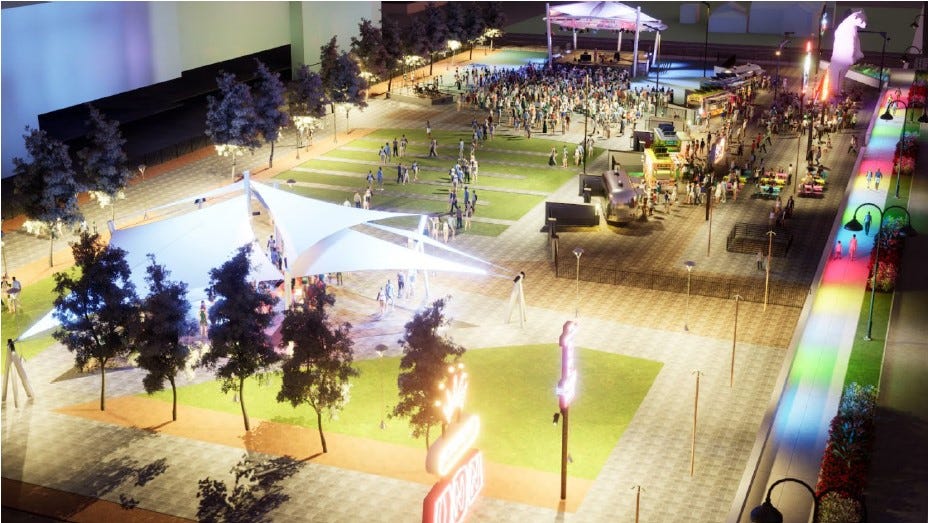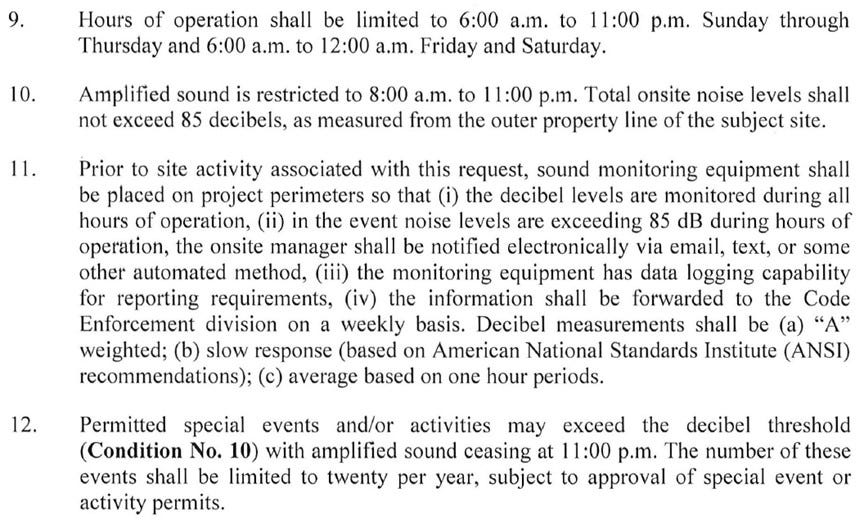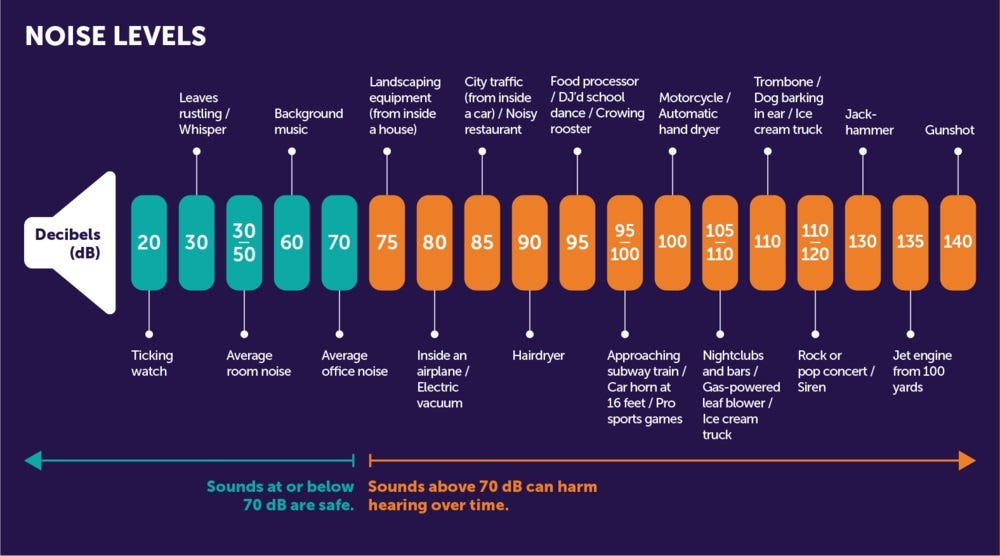Of Decibels and Demographics
Jacobs’ Glow Plaza & Festival Area Heads to City Council on May 11.
The year is speeding by so quickly, it’s hard to believe that it’s already May (especially considering yesterday’s freak snow squalls)! One consolation is that May is Reno’s birthday month—our beautiful city turns 154 this very day. For a glimpse back to Reno’s founding year of 1868, I invite you to read Jenny Kane’s recent article in the Reno Gazette-Journal about the Benham-Belz house at 347 West Street. My research indicates that it was built within months of the Central Pacific Railroad’s original land auction, a remarkable story of survival that offers us a rare glimpse into Reno’s fascinating origins as a modest but bustling national crossroads.
Fast forward to the present day, where you can catch City Council’s next meeting this Wednesday, May 11. The agenda and supporting materials can be accessed here, so be sure to skim through it for items of interest to you. I’ll just be talking about one today.
The Jacobs Glow Plaza and Festival Area
Item I.2 (that’s I as in Isaac) is the appeal of the Reno Planning Commission’s decision to approve a conditional use permit for Jacobs Entertainment’s “Glow Plaza and Festival Area.” This permit was approved by a slim 4-3 Planning Commission majority on March 16 (it was Item 5.3 on that agenda).

For some background, conditional use permits are granted by the Planning Commission and in most cases (with a few exceptions including skyways) do not proceed to City Council unless someone files an appeal, in which case City Council can affirm, modify, or reverse the Planning Commission’s decision. So that’s what happening here. There were three appeals of this particular decision—two by downtown residents and one by Jacobs Entertainment, that last one to preserve the applicant’s right to judicial review. Jacobs is also arguing that neither of the other appellants has “standing” and that their appeals should be dismissed.
You can read the full staff report explaining the application and required findings here. Coincidentally, this weekend, the nonprofit Scenic Nevada released a very helpful Special Alert about this appeal as well as the status of their lawsuit against the City over the Development Agreement with Jacobs, so please read that, too.
I’ve written about the proposed “Glow Plaza and Festival Area” before: in my March 12 post called “Putting the Pieces Together,” I compiled what information I could assemble about Jacobs’ future plans (including a TV interview with Jeff Jacobs that seemed largely to have gone under the radar); and in my February 7 Brief, “Reno’s Next Big Gamble," I explained how this project diverges from the city’s specific Master Plan guidelines for designated Urban Corridors like Fourth Street.
I won’t rehash those two posts, but my overall points were first, that Jacobs’ plans for this area diverge markedly from the approved, publicly vetted Master Plan for this pivotal central urban corridor, and that considering each of Jacobs’ new projects in a vacuum is not allowing for full consideration of how everything in the area will work together. So feel free to read those through.
You can watch the March 16 presentation to the Planning Commission from Jacobs Entertainment’s representative, attorney Garrett Gordon, starting here, and City staff’s presentation here.
[A quick note here: My husband, Mark Johnson, was appointed to the Reno Planning Commission by Ward 2 Councilmember Naomi Duerr in 2015. Prior to the March 16 meeting, Mark consulted with the City attorney’s office, who provided him with the text of a disclosure that his wife (yours truly) writes a blog about City development, including commentary on Jacobs projects, and that it had been determined that my authorship of the Brief would not materially affect his independent judgment of any such items, and that I derive no benefit or detriment from his deliberations or decisions—all true for this and every other project he or I might discuss.]
The problematic nature of the piecemeal plan
As Mr. Gordon noted in his introduction, this was his first appearance in front of the Planning Commission on behalf of Jacobs Entertainment. That will likely come as a surprise to some, considering the magnitude of the area covered by the City’s Development Agreement with the company.
The exclusion of the Planning Commission from review of Development Agreements was a deliberate decision on the part of our sitting City Council; as I wrote in my April 13, 2021 Brief, when revising that section of City Code back in September of 2020, Council rejected the Planning Commission’s own recommendation that they be allowed to review all Development Agreements prior to Council review. (The Planning Commission had also recommended that community workshops be held to discuss Development Agreements prior to any vote, which as we know, did not happen, either.)
The Glow Plaza has been discussed in Jacobs’ many presentations in front of Council, but neither it nor any Festival Area was described in the Development Agreement. As a reminder, that agreement left any actual development besides expansion and renovation of The Sands entirely vague. Below is its only reference to outdoor entertainment venues as part of an “array” of promised offerings to be included somewhere at some point (the document watermarked “Draft” is still the only one the City has posted, so I’m wondering exactly when—or if?--the agreement was finalized).
What would this permit allow?
The “Glow Plaza,” as many know, is the name Jacobs has given to the open space along West 4th Street between Ralston and Washington Streets, where they have held periodic events on a temporary stage. Last fall, I took this 360-degree video of the space, which shows the immediate context, from the Sands to the adjacent Sarrazin Arms and Onyx at 695, to the Desert Rose Inn, and other nearby residences and hotels.
This conditional use permit would allow for the construction of a permanent stage there and establish regulations for the types of activities allowed at this new Festival Area in perpetuity, eliminating the need to apply for separate Special Activity Permits for events under a certain threshold capacity—what were deemed “smaller” events.
City staff recommended that the threshold for these smaller events be set at events of 2,000 attendees or fewer, and that for any event under that threshold, amplified noise should be limited to 75 decibels (dB), in keeping with standard special events practice. (You can view the City’s application form for Special Activity Permits here, where regulations for amplified sound are discussed on p. 13).
This part of the conditional use permit would mean that Jacobs Entertainment would be allowed “by right” (i.e. without having to apply for a Special Activity Permit) to hold events and concerts on the site with amplified sound allowed between 8:00 a.m. and 11:00 p.m. any day or night of the year. Mr. Gordon, on behalf of Jacobs, requested that the threshold capacity for those “smaller” events be increased from 2,000 to 3,700, citing the availability of nearby parking, and a majority of the Planning Commission agreed to the request, nearly doubling the allowed capacity for “by right” events.
Additionally, the motion made by Planning Commissioner Alex Velto exceeded staff recommendations by raising the allowed decibel level for those events from 75 to 85 dB—something that Jacobs Entertainment was not even requesting.
In addition to these “smaller” events, the permit would allow Jacobs Entertainment to hold up to 20 events per year (each “event” lasting from 1-4 days) for which the sound could exceed 85 dB, with no maximum decibel level imposed. A Special Activity Permit would be required for such events due to their size, which could potentially fill the site’s stated capacity of more than 6,700. You can read the language for some of those conditions below--#10 and #11 pertain to the everyday regulations and #12 to the larger events. (The full list of conditions is available here under Exhibit D.)
So here’s what that means. If approved, the Glow Plaza and Festival Space could be the site of events with amplified sound reaching 85 decibels any day or night of the year, and events with no limit on noise levels (within allowed hours) for up to 80 days of the year (concentrated, one would imagine, in the warmer months).
In trying to understand how many decibels a typical concert reaches, I learned that outdoor rock concerts typically range between 90 and 100 decibels (indoor concerts can be even louder). Here’s a helpful chart from the Hearing Health Foundation.
It's important to understand, too, that the decibel scale is logarithmic, like the Richter scale for earthquakes. Each ten decibel increase is roughly equal to a tenfold increase in sound intensity, and is perceived as twice as loud—and, of course, sustained noise levels over a period of hours are experienced much differently than the occasional engine, motorcycle, or siren.
Mr. Gordon argued in his presentation that “This isn’t a new use for downtown,” citing the numerous special events that occur along Virginia Street every year. But this is absolutely a new use for downtown in general and especially for this location. Downtown has, through the years, been the site of countless special events on Virginia Street, several blocks to the east, but to my knowledge, no permit has ever been granted for outdoor events of this magnitude and decibel level on an ongoing basis without requiring separate Special Activity Permits. Downtown has an indoor Events Center and other indoor concert venues, a ballpark occasionally used for live performances, and a street that’s occasionally closed down for festivals. It does not have a dedicated outdoor 6,700-capacity entertainment venue, and it doesn’t do anyone any good to minimize the import of creating one.
In the Northwest Quadrant, where the site lies, the only precedent for ongoing outdoor live entertainment consists of Jacobs Entertainment’s previous events, which, as Mr. Gordon stated, have attracted approximately 100-150 people each, and even those have generated complaints from neighboring properties. So it’s safe to say that the City is entering new territory here and should proceed with all due deliberation and caution, keeping the big picture of residence and revitalization in mind and pondering the potential impact on our rapidly changing downtown environment.
What would this mean for neighboring residents?
As both staff and Mr. Gordon indicated, the approximately 2.32-acre, seven-parcel site in question is zoned Mixed-Use Downtown MD-NW (Northwest Quadrant), which allows for 24-hour activity, like any other part of downtown. But it’s worth noting that 24-hour activity is quite different than a potential 365 nights of 85 dB amplified sound and up to 80 nights per year of unlimited amplified sound and accompanying activity.
While many like to compare Reno to other cities, it’s always critical to note what sets our city apart. West 4th Street is not the Fremont Street Experience in Las Vegas. It’s not Jacobs Entertainment’s Nautica Waterfront District, perched at the edge of the Cuyahoga River in Cleveland. This is downtown Reno, which has been rapidly transforming over the past two decades into an increasingly dense, increasingly residential mixed-use area. Former hotels and hotel-casinos have or will soon become residences, from the Riverside Hotel (Artist Lofts) to the Sahara Reno (the Montage), Comstock (Riverwalk Tower), Kings Inn (3rd Street Flats), Harrah’s Reno (Reno City Center), and soon, the Riverboat.
Added to that, new multi-family residences are being constructed nearby at a rapid clip, including a whole row of new apartment buildings on West 2nd Street and north of the Gold Dust West. Jacobs Entertainment itself has had two potentially residential sites up for sale for months now, one on Keystone Avenue and another on Fifth Street, and has pitched the notion of a high-rise, high-volume multifamily apartment building (and parking structure) one block south of the Glow Plaza.
Just how permanent authorization of a live outdoor entertainment venue in such close proximity might impact those future residents is hard to say. What’s easier to determine is the potential impact on those who already live in the area, from the residents of the apartments and condos just to the east to those living at the Desert Rose Inn, across West 4th Street from the Glow Plaza. And that’s where these appeals come in, filed by Montage resident Art Rangel, AICP, and by Lacy Foster, resident and manager of the Desert Rose.
Mr. Rangel has provided a detailed explanation of his appeal, and I encourage everyone to read it, as it thoroughly and thoughtfully lays out the reasons why he feels that a conditional use permit enabling blanket permissions for the types of events described above is not appropriate at this time (it’s about more than just decibel levels).
Jacobs rep Mr. Gordon offered to speak to Montage residents about the Glow Plaza, as he spoke with those attending the Ward 1 and Ward 5 Neighborhood Advisory Boards. But those of us who are fully tapped into such meetings and public notices need always to be cognizant that we are a small minority compared to those for whom such meetings aren’t front of mind. Renters, in particular, are often bypassed by public notices, which are generally directed at property owners, not tenants. Were residents of the Onyx and Sarrazin Arms offered a presentation about the Glow Plaza? Did they even receive notices? How many residents of the Onyx’s 240 units are children or seniors? Do we know? Did anyone ask? The Desert Rose Inn that Lacy Foster manages is a long-term residence for people of all ages, as profiled in 2017 by Our Town Reno here. What do we know of them and their thoughts on the matter?
We can also gain valuable insight from other downtown residents facing similar circumstances. One public comment at the Planning Commission meeting came from Ivy Antonowitsch, a 15-year resident of the Riverside Artist Lofts. In her public comment (listen here), she described how her quality of life has been impacted by the amplified music from The Eddy, the seasonal open-air beer garden and gathering space that opened next door in 2017—as close to the Riverside as the Glow Plaza is to the Onyx. Her words demand attention and compassion, to ensure that such perspectives and experiences are fully acknowledged and openly discussed, before making decisions that would potentially impact the daily lives of thousands.
The only City code restrictions on noise pertaining to residential areas (Article 18.04.1408) apply to those that are entirely residential, where daytime noise levels (6:00 a.m. to 7:00 p.m.) are limited to 65 dB and nighttime (10 p.m. to 7:00 a.m.) to 49 dB. Should the same noise ordinances be implemented in our downtown? Of course not. The decision to live in a downtown area carries with it the expectation of a certain degree of ambient, and occasionally event-based, urban noise. But when does that noise become excessive, and how will our City center adapt to the changing uses and demographics that are rapidly transforming it from the casino hub of yesteryear?
Jacobs Entertainment has floated a vision of a mixed-use district with 2,000 to 3,000 residential units in the Northwest Quadrant. However, so far, what they are building on West 4th Street is primarily a resort. And don’t forget, as Mr. Jacobs mentioned in his recent interview, he also has aspirations to build an outdoor amphitheater south of The Sands, even closer to existing apartments and condos. Ideally, the Development Agreement would have described both of these proposed projects in detail, enabling the City to conduct a thorough and realistic examination of the potential combined impact of not one, but two such venues, to more accurately determine whether they would truly be compatible with the City’s stated desire to intensify residential density in the exact same area. Because it did not, we must piece together that big picture ourselves, and it’s critical that we (and our representatives) do.
Your Voice Matters.
Appellant Art Rangel is not asking that Jacobs Entertainment be prevented from holding events on the Glow Plaza or the new Festival Area, but simply requesting that the City hold off on this conditional use permit for now, and stick with the existing arrangement requiring Special Activity Permits for any events held there, until the potential impact of these types of planned events can accurately be determined.
I encourage anyone who’s interested in downtown revitalization to comment on this item, I.2 (that’s I as in Isaac) either prior to Wednesday’s meeting or in person. I think it’s especially important for residents of downtown to let City Council know your thoughts about it—and not just property owners, but renters, too. As indicated on the agenda (which you can view here), the appeal will be heard no earlier than 6:00 pm on Wednesday, May 11. You can attend and provide public comment via Zoom by registering here, submit the online public comment form, send an email to publiccomment@reno.gov, or leave a voice mail at (775) 393-4499.
As always, you can view this and prior newsletters on my Substack site and follow the Brief (and contribute to the ongoing conversation) on Twitter, Facebook & Instagram. If you feel inspired to contribute to my efforts, my Venmo account is @Dr-Alicia-Barber and you can mail checks, if you like, to Alicia Barber at P.O. Box 11955, Reno, NV 89510. Thanks so much for reading, and have a great week.







10dB increase is 10x louder, 20dB increase is 100x louder